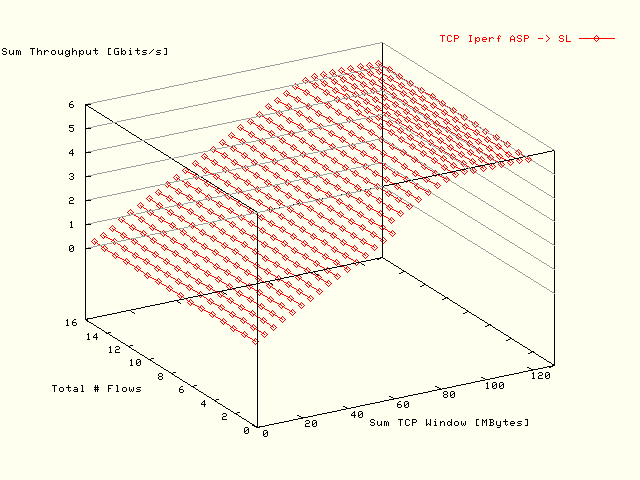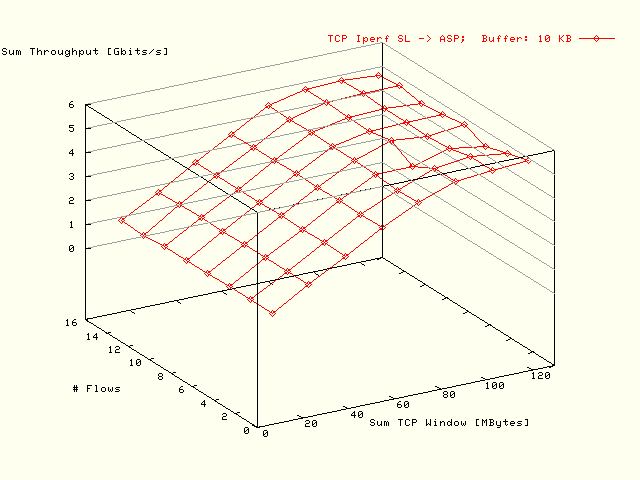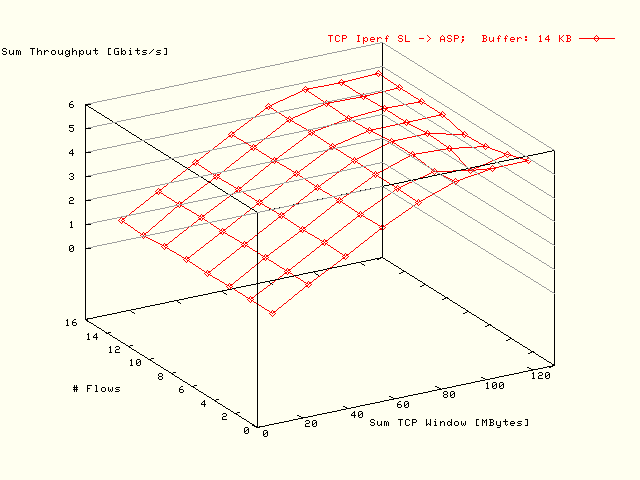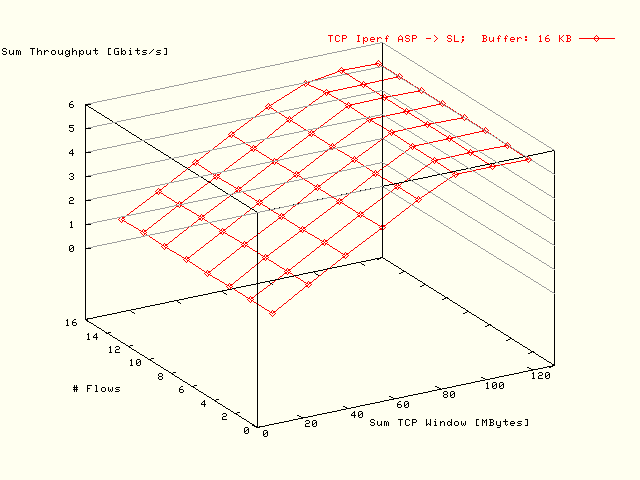TCP Tests
Description
As mentioned before, these tests have
been executed to get an expression about the network performance of both Itanium
hosts and their connecting network. Again the
Iperf V. 1.6.5 traffic
generator has been used to generate the TCP flows between both hosts. It has the
advantage that multiple, parallel flows can be generated relatively
light-weighted by using the so called pthread library.
The TCP tests have been executed as a function of the # parallel flows
between both hosts, and of the TCP window size which will be varied such that
the sum of the TCP window over the # parallel flows will be kept constant.
This make a better comparison possible of the results of the various
# parallel flows, as the achieved TCP throughput is a.o. dependent from the
total TCP window size.
Results
The results of the following TCP tests have been presented in this section:
-
A small step-size variation of the TCP window and of the # parallel
flows with a fixed socket buffer size of 8000 Bytes.
-
A larger step-size variation of the TCP window and of the # parallel
flows . Also the socket buffer size has been varied here.
Fixed Socket Buffer Size
Below the results of TCP throughput tests have been shown as a function of the
sum TCP window (taken over the # flows), and of the # parallel flows
between both Itanium hosts. Also the throughput values are sums taken over the
# parallel flows. In these tests a fixed socket buffer size of
8000 Bytes have been used. The test duration was 60 s. Each 4 s
a bandwidth interval report has been generated by
Iperf.
From these interval reports the TCP throughput values
were calculated as described below. In general the
Iperf interval reports do
not exactly match intervals of 4 s. Therefore, these reports are resampled
by means of linear interpolation such that they are exactly 4 s intervals.
The results of the parallel flows for the same interval are summed. From these
summed values the median is calculated. By taking the median there will be
corrected for TCP slow startup effects.
In the following plots results are presented from December 17, 2003.
That is before the period when there were some hardware problems with the
Chicago Itanium. Further below analogous results are presented when these
problems had been fixed again. In
the sum TCP throughput has been displayed as a function of the sum TCP window
and the # flows for the direction StarLight ->
Amsterdam Science Park and in
for the reverse direction.

| . |
|
Sum TCP throughput values, taken over the
# parallel flows, as a function of the sum TCP window size, also taken
over the # parallel flows, and of the # parallel flows for the
test direction StarLight -> Amsterdam Science
Park. The test date was December 17, 2003. |

| . |
|
Sum TCP throughput values, taken over the
# parallel flows, as a function of the sum TCP window size, also taken
over the # parallel flows, and of the # parallel flows for the
test direction Amsterdam Science Park ->
StarLight. The test date was
December 17, 2003. |
In
the average TCP throughput per flow has been displayed as a function of the TCP
window size per flow for the test direction StarLight ->
Amsterdam Science Park. The results for some # parallel flows have
been represented here by corresponding plot traces. In
these data have been presented for the reverse direction.

| . |
|
Average TCP throughput values per flow as a function
of the TCP window size per flow for the test direction
StarLight -> Amsterdam Science Park. The results
for some # parallel flows have been represented by corresponding plot
traces. The test date was December 17, 2003. |

| . |
|
Average TCP throughput values per flow as a function
of the TCP window size per flow for the test direction Amsterdam
Science Park -> StarLight. The results for some
# parallel flows have been represented by corresponding plot traces.
The test date was December 17, 2003. |
In the
corresponding figures have been presented as in the
,
but here for results that were obtained at February 17, 2004. That is
after the hardware problems with the Chicago Itanium had been solved. Another
difference with the previous results is that the maximum TCP window size per
flow has been limited to 64 MBytes. The reason was that at that moment
there were some suspicions that using large TCP window sizes could lead to
problems in the OS.

| . |
|
Sum TCP throughput values, taken over the
# parallel flows, as a function of the sum TCP window size, also taken
over the # parallel flows, and of the # parallel flows for the
test direction StarLight -> Amsterdam Science
Park. The maximum window size per flow has been limited to
64 MBytes/s and the test date was
February 17, 2004. |

| . |
|
Sum TCP throughput values, taken over the
# parallel flows, as a function of the sum TCP window size, also taken
over the # parallel flows, and of the # parallel flows for the
test direction Amsterdam Science Park ->
StarLight. The maximum window size per flow has been limited to
64 MBytes/s and the test date was
February 17, 2004. |

| . |
|
Average TCP throughput values per flow as a function
of the sum TCP window size per flow for the test direction
StarLight -> Amsterdam Science Park. The results
for some # parallel flows have been represented by corresponding plot
traces. The maximum window size per flow has been limited to
64 MBytes/s and the test date was
February 17, 2004. |

| . |
|
Average TCP throughput values per flow as a function
of the sum TCP window size per flow for the test direction
Amsterdam Science Park -> StarLight. The results
for some # parallel flows have been represented by corresponding plot
traces. The maximum window size per flow has been limited to
64 MBytes/s and the test date was
February 17, 2004. |
From the results displayed in the
the following conclusions can be drawn:
-
The obtained results are largely independent from the # flows. This is
an indication that there are few strong host related artifacts.
-
In the executed at December 17, 2003 no directional effects were
found, while in the tests that were executed at February 17, 2004,
the throughput in the direction Amsterdam Science Park ->
StarLight is slightly higher as in the reverse direction.
Socket Buffer Size Variation
In this section the influence of the socket buffer size variation has been
studied. The other test parameters are the same as in the
previous section, but also the socket
buffer size has been varied from 2 KBytes to 16 KBytes.
In the
the sum of the TCP throughput values, taken over the # parallel flows, has
been displayed as a function of the sum of the TCP window size, also taken over
the # parallel flows and the socket buffer size (per flow). In these
figures the results have been presented for 2, 4, ...,
16 parallel flows in the direction StarLight ->
Amsterdam Science Park. The
are showing the corresponding results for the reverse direction
Amsterdam Science Park -> StarLight.

| . |
|
Sum TCP throughput values, taken over the
# parallel flows, as a function of the sum TCP window size, also taken
over the # parallel flows, and of the socket buffer size for the
test direction StarLight -> Amsterdam Science
Park using 2 parallel flows. |

| . |
|
Sum TCP throughput values, taken over the
# parallel flows, as a function of the sum TCP window size, also taken
over the # parallel flows, and of the socket buffer size for the
test direction StarLight -> Amsterdam Science
Park using 4 parallel flows. |

| . |
|
Sum TCP throughput values, taken over the
# parallel flows, as a function of the sum TCP window size, also taken
over the # parallel flows, and of the socket buffer size for the
test direction StarLight -> Amsterdam Science
Park using 6 parallel flows. |

| . |
|
Sum TCP throughput values, taken over the
# parallel flows, as a function of the sum TCP window size, also taken
over the # parallel flows, and of the socket buffer size for the
test direction StarLight -> Amsterdam Science
Park using 8 parallel flows. |

| . |
|
Sum TCP throughput values, taken over the
# parallel flows, as a function of the sum TCP window size, also taken
over the # parallel flows, and of the socket buffer size for the
test direction StarLight -> Amsterdam Science
Park using 10 parallel flows. |

| . |
|
Sum TCP throughput values, taken over the
# parallel flows, as a function of the sum TCP window size, also taken
over the # parallel flows, and of the socket buffer size for the
test direction StarLight -> Amsterdam Science
Park using 12 parallel flows. |

| . |
|
Sum TCP throughput values, taken over the
# parallel flows, as a function of the sum TCP window size, also taken
over the # parallel flows, and of the socket buffer size for the
test direction StarLight -> Amsterdam Science
Park using 14 parallel flows. |

| . |
|
Sum TCP throughput values, taken over the
# parallel flows, as a function of the sum TCP window size, also taken
over the # parallel flows, and of the socket buffer size for the
test direction StarLight -> Amsterdam Science
Park using 16 parallel flows. |
Show also the plots from the
as
in a new browser window.

| . |
|
Sum TCP throughput values, taken over the
# parallel flows, as a function of the sum TCP window size, also taken
over the # parallel flows, and of the socket buffer size for the
test direction Amsterdam Science Park -> StarLight
using 2 parallel flows. |

| . |
|
Sum TCP throughput values, taken over the
# parallel flows, as a function of the sum TCP window size, also taken
over the # parallel flows, and of the socket buffer size for the
test direction Amsterdam Science Park -> StarLight
using 4 parallel flows. |

| . |
|
Sum TCP throughput values, taken over the
# parallel flows, as a function of the sum TCP window size, also taken
over the # parallel flows, and of the socket buffer size for the
test direction Amsterdam Science Park -> StarLight
using 6 parallel flows. |

| . |
|
Sum TCP throughput values, taken over the
# parallel flows, as a function of the sum TCP window size, also taken
over the # parallel flows, and of the socket buffer size for the
test direction Amsterdam Science Park -> StarLight
using 8 parallel flows. |

| . |
|
Sum TCP throughput values, taken over the
# parallel flows, as a function of the sum TCP window size, also taken
over the # parallel flows, and of the socket buffer size for the
test direction Amsterdam Science Park -> StarLight
using 10 parallel flows. |

| . |
|
Sum TCP throughput values, taken over the
# parallel flows, as a function of the sum TCP window size, also taken
over the # parallel flows, and of the socket buffer size for the
test direction Amsterdam Science Park -> StarLight
using 12 parallel flows. |

| . |
|
Sum TCP throughput values, taken over the
# parallel flows, as a function of the sum TCP window size, also taken
over the # parallel flows, and of the socket buffer size for the
test direction Amsterdam Science Park -> StarLight
using 14 parallel flows. |

| . |
|
Sum TCP throughput values, taken over the
# parallel flows, as a function of the sum TCP window size, also taken
over the # parallel flows, and of the socket buffer size for the
test direction Amsterdam Science Park -> StarLight
using 16 parallel flows. |
Show also the plots from the
as
in a new browser window.
Below a different view will been given from the data that had been presented in
the
in the sense that plots of the sum TCP throughput values are presented as a
function of the sum TCP window size and the # parallel flows. In the
results have been presented for socket buffer sizes of 2, 4, ...
16 KBytes in the direction StarLight ->
Amsterdam Science Park and in the
for the reverse direction.

| . |
|
Sum TCP throughput values, taken over the
# parallel flows, as a function of the sum TCP window size, also taken
over the # parallel flows, and of the # parallel flows for the
test direction StarLight -> Amsterdam Science Park
using a socket buffer size of 2 KBytes. |

| . |
|
Sum TCP throughput values, taken over the
# parallel flows, as a function of the sum TCP window size, also taken
over the # parallel flows, and of the # parallel flows for the
test direction StarLight -> Amsterdam Science Park
using a socket buffer size of 4 KBytes. |

| . |
|
Sum TCP throughput values, taken over the
# parallel flows, as a function of the sum TCP window size, also taken
over the # parallel flows, and of the # parallel flows for the
test direction StarLight -> Amsterdam Science Park
using a socket buffer size of 6 KBytes. |

| . |
|
Sum TCP throughput values, taken over the
# parallel flows, as a function of the sum TCP window size, also taken
over the # parallel flows, and of the # parallel flows for the
test direction StarLight -> Amsterdam Science Park
using a socket buffer size of 8 KBytes. |

| . |
|
Sum TCP throughput values, taken over the
# parallel flows, as a function of the sum TCP window size, also taken
over the # parallel flows, and of the # parallel flows for the
test direction StarLight -> Amsterdam Science Park
using a socket buffer size of 10 KBytes. |

| . |
|
Sum TCP throughput values, taken over the
# parallel flows, as a function of the sum TCP window size, also taken
over the # parallel flows, and of the # parallel flows for the
test direction StarLight -> Amsterdam Science Park
using a socket buffer size of 12 KBytes. |

| . |
|
Sum TCP throughput values, taken over the
# parallel flows, as a function of the sum TCP window size, also taken
over the # parallel flows, and of the # parallel flows for the
test direction StarLight -> Amsterdam Science Park
using a socket buffer size of 14 KBytes. |

| . |
|
Sum TCP throughput values, taken over the
# parallel flows, as a function of the sum TCP window size, also taken
over the # parallel flows, and of the # parallel flows for the
test direction StarLight -> Amsterdam Science Park
using a socket buffer size of 16 KBytes. |
Show also the plots from the
as
in a new browser window.

| . |
|
Sum TCP throughput values, taken over the
# parallel flows, as a function of the sum TCP window size, also taken
over the # parallel flows, and of the # parallel flows for the
test direction Amsterdam Science Park -> StarLight
using a socket buffer size of 2 KBytes. |

| . |
|
Sum TCP throughput values, taken over the
# parallel flows, as a function of the sum TCP window size, also taken
over the # parallel flows, and of the # parallel flows for the
test direction Amsterdam Science Park -> StarLight
using a socket buffer size of 4 KBytes. |

| . |
|
Sum TCP throughput values, taken over the
# parallel flows, as a function of the sum TCP window size, also taken
over the # parallel flows, and of the # parallel flows for the
test direction Amsterdam Science Park -> StarLight
using a socket buffer size of 6 KBytes. |

| . |
|
Sum TCP throughput values, taken over the
# parallel flows, as a function of the sum TCP window size, also taken
over the # parallel flows, and of the # parallel flows for the
test direction Amsterdam Science Park -> StarLight
using a socket buffer size of 8 KBytes. |

| . |
|
Sum TCP throughput values, taken over the
# parallel flows, as a function of the sum TCP window size, also taken
over the # parallel flows, and of the # parallel flows for the
test direction Amsterdam Science Park -> StarLight
using a socket buffer size of 10 KBytes. |

| . |
|
Sum TCP throughput values, taken over the
# parallel flows, as a function of the sum TCP window size, also taken
over the # parallel flows, and of the # parallel flows for the
test direction Amsterdam Science Park -> StarLight
using a socket buffer size of 12 KBytes. |

| . |
|
Sum TCP throughput values, taken over the
# parallel flows, as a function of the sum TCP window size, also taken
over the # parallel flows, and of the # parallel flows for the
test direction Amsterdam Science Park -> StarLight
using a socket buffer size of 14 KBytes. |

| . |
|
Sum TCP throughput values, taken over the
# parallel flows, as a function of the sum TCP window size, also taken
over the # parallel flows, and of the # parallel flows for the
test direction Amsterdam Science Park -> StarLight
using a socket buffer size of 16 KBytes. |
Show also the plots from the
as
in a new browser window.
From the results presented in this section, where also the socket buffer size
have been varied the following can be concluded:
-
Variation of the socket buffer size does not show much effect.
-
Also in these results the performance in the direction
Amsterdam Science Park -> StarLight is slightly
better than in the reverse direction.
Conclusions
From the TCP tests the following conclusions can be drawn:
-
The TCP performance of the Itanium hosts is as could be expected
theoretically. There are no differences in the performance as a function of
the # flows. This probably implies that there no severe host
implementation limitations.
-
The maximum throughput in the direction
Amsterdam Science Park -> StarLight is about
5.2 Gbits/s and 5.0 Gbits/s. The differences may also be related
with the differences in used Linux kernels.
-
Variation of the socket buffer size does not have much influence in the
obtained TCP throughput values.







































